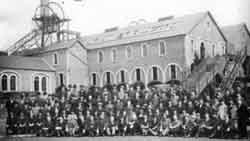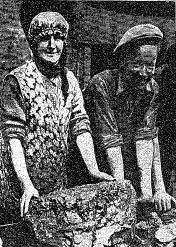Hamilton Palace Colliery

11 Aug 1899
Report on Mining Institute of Scotland
The annual excursion of the Institute took place yesterday, the destination being Bent Colliery Companys Hamilton Palace Colliery. The visitors were on their arrival received by Mr J S Dixon, managing director, and were thereafter shown over the workings. The day was very fine, and the members of the Institute who came from all parts of the country, enjoyed themselves to the full. It may be stated by way of description that the electric plant hauls distances of 1400 and 1000 yards, and when a mine now being driven is completed, another haulage of abut 1200 yards long is to be added. Tail rope engines underground haul distances of 1300, 500 and 400 yards respectively, and a single rope hauls 400 yards. The development of the workings was greatly hindered by the intervention of numerous troubles. And the mines that had to be driven, but to some extent this has been overcome by the introduction of Stanley heading machines driven by compressed air, with which some miles of headings were driven at about four times the speed of hand; but the shafts have lately been sunk a further depth of 60 fathoms, from which mines are being driven to level out the main and splint seams near the centre, and in the latter case at the deepest part of the field. It may be added that the field has proved a rather troubled one, but under the skill and indomitable will of Mr J S Dixon, ME, managing director, ably supported by Mr Archibald Blyth, general manager, and the application of the most advanced mechanical and mining science, aptly applied, all difficulties are in a fair way to being, if they have not already been, overcome. Engines on the surface haul the coal for distances of 1200, 1000, and 1200 yards respectively. The coalfield, which is the largest in Lanarkshire, if not in Scotland, is worked from a pair of pits, in the form of an irregular parallelogram, and area of about one and three-quarter miles long by three quarters of a mile wide, while the workings stretch from the pits about one and a half mile in a south easterly direction and about three-quarter miles in a westerly direction. The colliery is fitted with two shafts, each 24 by 8 feet, the ell being got out at a depth of 97 fathoms. At present only No.1 pit is producing coal. The output averaged 1000 tons per day of nine hours, the record being 1161 tons in that time. The output for the last three months has been 72,865 tons or at the rate, including holidays, of about 280,000 tons per annum, from an ordinary winding shaft. The Company look forward to an equal output from No 2 pit when the mines are completed and the coal workings developed. There are 250 houses built in a superior style for the workmen, which, with a neat schoolhouse, a store worked by the men on the co-operative system, and a recreation hall, forms quite a model colliery village on Bothwellhaugh, facing the long avenue which terminates with a full view of Hamilton Palace.
July 19th 1911
Mr Dixon was born in Glasgow in 1850 and educated at Hamilton Academy and at Glasgow University. In 1872 he leased the Bent Colliery and afterwards he acquired the coalfields under Hamilton Palace grounds, both collieries being worked by a company of which he was managing owner. Mr Dixon was appointed a member of the Royal Commission on the Coal Supplies of Great Britain, and his report upon the available resources of Scotland is the standard authority on the subject. He took a great interest in the formation of the Mining Institute of Scotland and was elected president, and he had the further honour of being selected for the presidency of the Institution of Mining Engineers of Great Britain. Mr Dixon gave £10,000 to found a Lectureship of Mining in Glasgow University, and by further donation of £6,500 the Lectureship was converted 5 years ago into a Chair. The University conferred on him the honorary degree of LLD in 1906. [The Times 19 July 1911]
 | Left: The last woman coalsorter at Hamilton Palace Colliery, 1937 | Above: Group of Bothwellhaugh Miners |
